Main topics: 1. Photosynthesis 2. Nutrition in animals 3. Respiration 4. Transportation 5. Excretion
Plant Nutrition/Photosynthesis
The process by which green plants prepare their food with the help of chlorophyll, sunlight , water and carbon dioxide.
Reaction of photosynthesis:

Steps of photosynthesis:
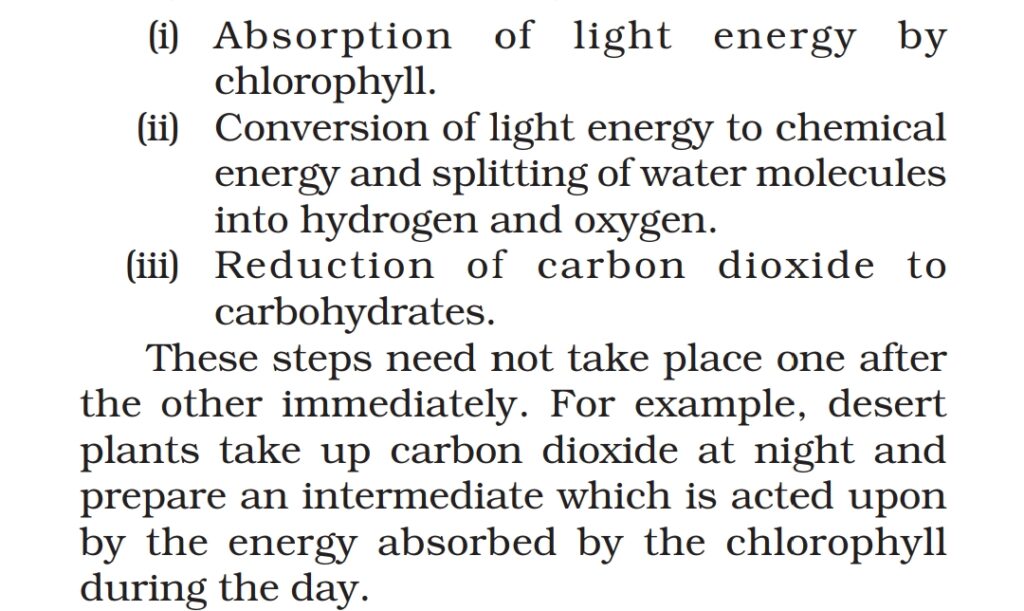
Q. Label the diagram of cross section of leaf.
Ans.
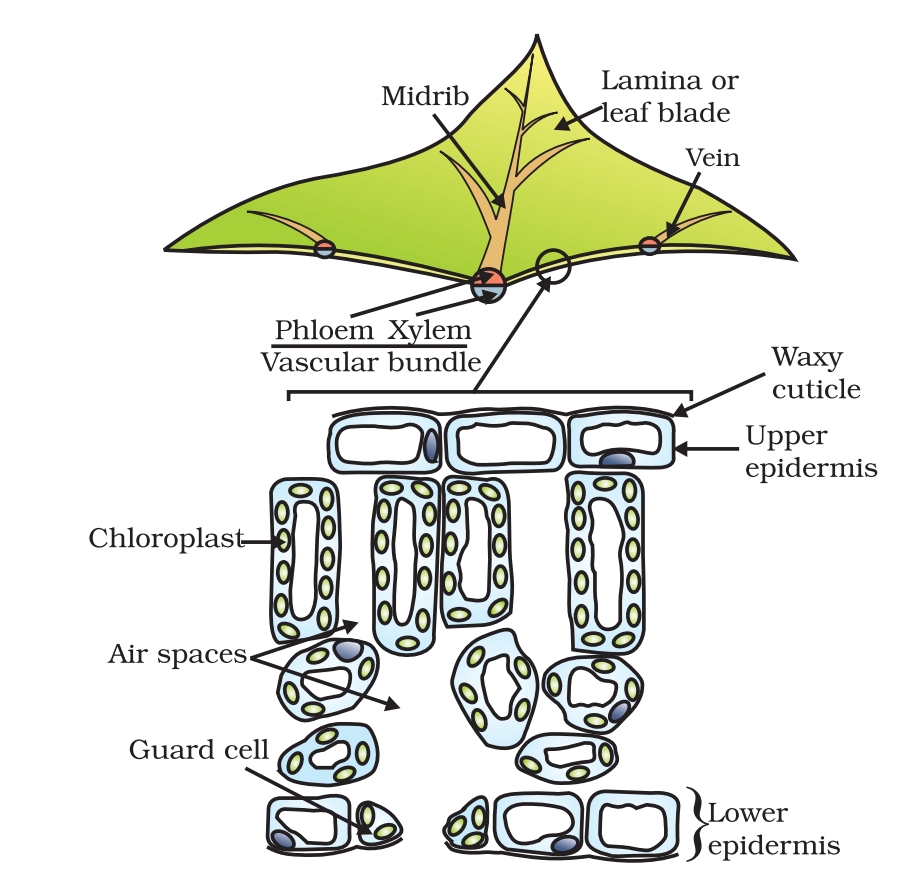
Note:
- CO2 is taken by plants through stomata.
- Sun light is trapped by chlorophyll
- All plants which do not have chloroplasts, couldn’t perform photosynthesis.
- Safranin is used to stain plant cell preparations to examine stomata under a microscope.
- Iodine can be used to stain starch to show the shapes and sizes of starch granules in plant tissues.
- Stains are chemical compounds used to colour part of the cell to study detailed structure.
- Water used in photosynthesis is taken up from the soil by the roots in terrestrial plants. Other materials like nitrogen, phosphorus, iron and magnesium are taken up from the soil. Nitrogen is an essential element used in the synthesis of proteins and other compounds. This is taken up in the form of inorganic nitrates or nitrites. Or it is taken up an organic compounds which have been prepared by bacteria from atmospheric nitrogen.
Q. How opening and closing of stomatal pores be controlled?
Ans. The opening and closing of the pore is a function of the guard cells. The guard cells swell when water
flows into them, causing the stomatal pore to open. Similarly the pore closes if the guard cells shrink.
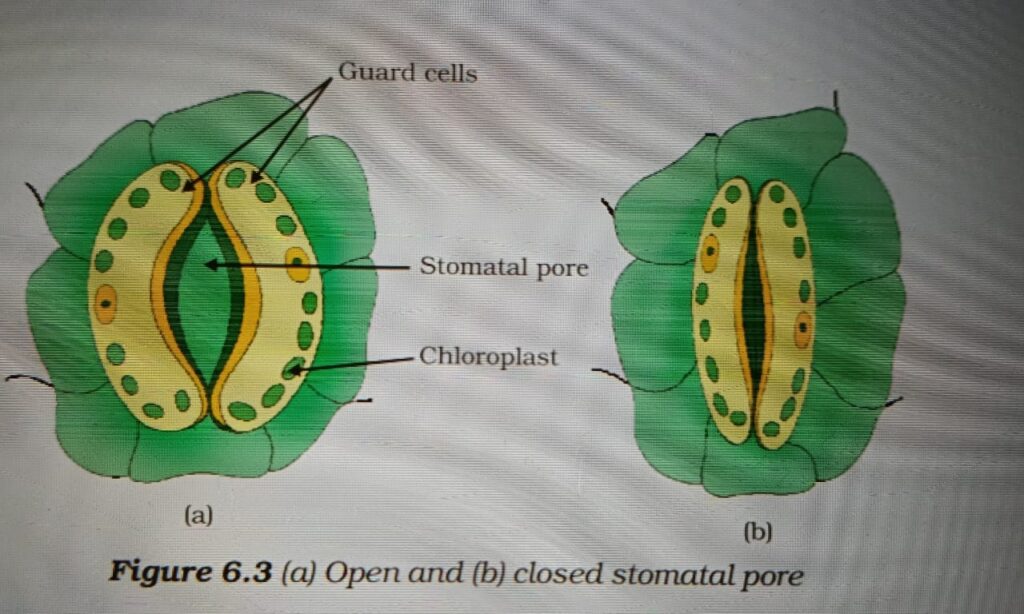
Heterotrophic Nutrition
- Parasitic Nutrition: Parasitic nutrition is a type of heterotrophic nutrition where an organism, called a parasite, lives on or inside another organism, called the host, and takes nutrients from it. Examples. cuscuta (amar-bel), orchids, ticks, lice, leeches and tape-worms.
- Saprophytic Nutrition: Saprophytes are organisms that feed on this dead and decaying material, and are also known as decomposers of nature. They release enzymes on food outside and digest it and then absorb the digested food. Examples fungi.
- Holozoic Nutrition: Digestion takes place inside the body with the help of enzymes. Examples nutrition in Amoeba, nutrition in human.
- Nutrition in Amoeba: Amoeba takes in food using temporary finger-like extensions of the cell surface which fuse over the food particle forming a food-vacuole. Inside the food-vacuole, complex substances are broken down into simpler ones which then diffuse into the cytoplasm. The remaining undigested material is moved to the surface of the cell and thrown out.
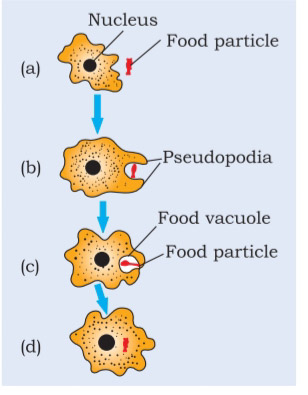
Nutrition in Paramecium: Paramoecium is a unicellular organism, the cell has adefinite shape and food is taken in at a specific spot. Food is moved to this spot by the movement of cilia which cover the entire surface of the cell.
Nutrition in Human
- The alimentary canal or digestive tract is a tube-like structure that runs from the mouth to the anus and is a key part of the digestive system:
- Sequence of elementary canal : buccal cavity, oesophagus, stomach, small intestine, large intestine.
- Digestion: Breaking down of complex food into simplest form with the help of biological catalyst called enzymes so that cells can use to produce energy and synthesis other important material.
Important Enzymes
- Salivary Amylase: The saliva contains an enzyme called salivary amylase that breaks down starch which is a complex molecule to give simple sugar.
- Gastric Enzymes: a. Hydrochloric Acid b. Mucous c. Pepsin
- Hydrochloric Acid: Produced by gastric glands in the stomach. It’s function include (i) it kills microbes(ii) make medium of food acidic for better action of pepsin.
- Mucous: Secreted by gastric glands in the stomach. It protect lining of wall of stomach from the corrosive nature of hydrochloric Acid. It evenly spread over the surface of stomach so that mucous couldn’t reach on the surface of stomach.
- Pepsin: It is protein digestive enzyme produced by gastric glands in the stomach. It performs well in acidic medium.
- 3. Lipase: It is produced by pancreas. It works in small intestine. It digest emulsified fat.
- 4. Trypsin: It is produced by pancreas. It works in small intestine. It is protein digestive enzyme. It performs well in basic medium.
- 5. Bile Juice: It is produced by liver. It is stored in gall bladder. It creates alkaline ( basic) medium in small intestine for better action trypsin.
- 6. Bile Salt: Present in bile juice. It breaks large fat globules into smaller, which is called emulsification of fat.
- 7. Intestinal Juice: Produced by small intestine. Final digestion of fat, protein, carbohydrate is carried out by intestinal juice. It converts carbohydrate into glucose, protein into amino acids and fat into fatty acid and glycerol.
Q. Explain digestion of carbohydrate.
Ans. Digestion in buccal cavity: The saliva contains an enzyme called salivary amylase that breaks down starch (carbohydrate) which is complex molecule to give sugar. The food is mixed thoroughly with saliva and moved around the mouth while chewing by the muscular tongue.
Digestion in small intestine: Final digestion of carbohydrate into glucose is done by intestinal juice .
Q. Explain the digestion of protein.
Ans. Site of digestion- buccal cavity, stomach, small intestine.
Digestion in buccal cavity: Food is broken down into smaller pieces by teeth. Mixed with saliva for easy passes through oesophagus.
Digestion in stomach: Stomach wall consists of gastric glands which produce hydrochloric acid, mucous and pepsin. Pepsin digest protein in stomach in acidic medium.
Digestion in small intestine: Intestinal juice finally digest protein into amino acids.
Q. Explain digestion of fat.
Ans. Digestion of fa mainly takes place in the small intestine. Fats are present in the form of large fat globules. Bile salt present in the bile juice break these fat globules into simpler form. This process is called emulsification of fat. Lipase, a pancreatic enzyme digest these emulsified fat. Final digestion of fat is carried out by intestinal juice into fatty acids and glycerol.
Define peristaltic movement.
Ans. The rhythmic contraction and relaxation of oesophagus and alimentary canal to push food forward is called peristaltic movement.
Q. How food passes from stomach to small intestine?
Ans. The exit of food from the stomach is regulated by a sphincter muscle which releases it in small amounts into the small intestine.
Q. How small intestine is designed? Or explain the structure small intestine.
Ans. longest part of the alimentary canal which is fitted into a compact space because of extensive coiling. The length of the small intestine differs in various animals depending on the food they eat. Herbivores eating grass need a longer small intestine to allow the cellulose to be digested. Meat is easier to digest, hence carnivores like tigers have a shorter small intestine. The small intestine is the site of the complete digestion of carbohydrates, proteins and fats. It receives the secretions of the liver and pancreas for this purpose.
Q. Explain the structure and function of villi.
Ans. The inner lining of the small intestine has numerous finger-like projections called villi which increase the surface area for absorption. The villi are richly supplied with blood vessels which take the absorbed food to each and every cell of the body, where it is utilised for obtaining energy, building up new tissues and the repair of old tissues.
Q. Label digestive system of human.
Ans.
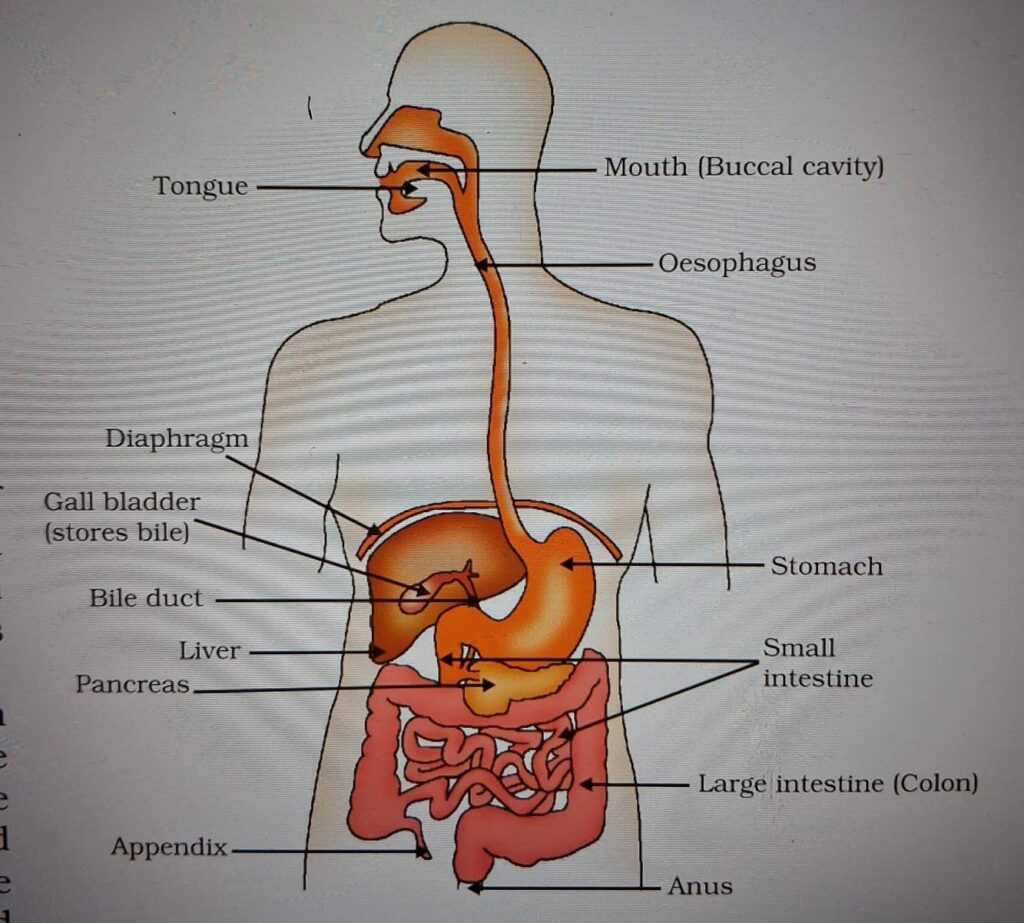
Respiration in human
Q. Differentiate breathing and cellular respiration.
Ans. Inhaling Oxygen and exhaling carbon dioxide is called breathing is called breathing. Cellular respiration is breaking down of pyruvate to provide energy with or without oxygen is called respiration. Breathing is a physical process carried out by the process of diffusion. Cellular respiration is a chemical process.
Q. Define glycolysis. Draw a diagram to show to show breaking down of pyruvate to provide energy. Or pathways of breaking down of glucose.
Ans. Breaking down of glucose (6 carbon molecule) into pyruvate ( 3 carbon molecule) in cytoplasm is called glycolysis.
Breaking down of pyruvate: 1. Pyruvate is converted through yeast into ethanol, carbon dioxide and energy (anaerobic respiration- respiration without oxygen 2. Pyruvate is converted in muscle cell of animal into lactic acid and energy due to lack of oxygen. 3. Pyruvate is converted in mitochondria of cell into carbon dioxide, water and energy with sufficient oxygen (aerobic respiration.in the access oxygen).
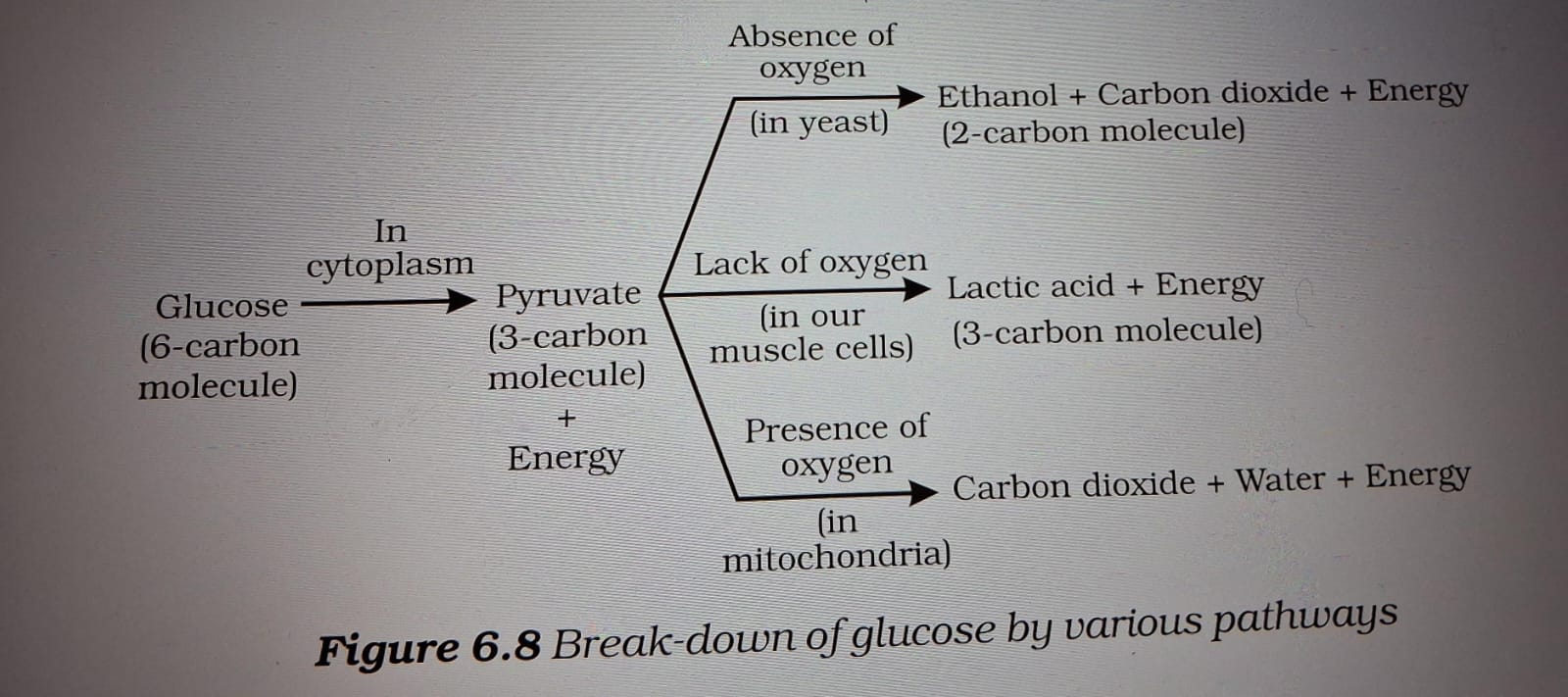
Note: The energy released during cellular respiration is immediately used to synthesise a molecule called ATP which is used to fuel all other activities in the cell.
Q. Why breathing rate of aquatic organism is high?
Ans. Since the amount of dissolved oxygen is fairly low compared to the amount of oxygen in the air, the rate of breathing in aquatic organisms is much faster than that seen in terrestrial organisms. Fishes take inwater through their mouths and force it past the gills where the dissolved oxygen is taken up by blood.
Q. Explain the mechanism of breathing.
Ans.
In human beings , air is taken into the body through the nostrils. The air passing through the nostrils is filtered by fine hairs that line the passage. The passage is also lined with mucus which helps in this process. From here, the air passes through the throat and into the lungs. Rings of cartilage are present in the throat. These ensure that the air-passage does not collapse.
- Within the lungs, the passage divides into smaller and smaller tubes which finally terminate in balloon-like structures which are called alveoli. The alveoli provide a surface where the exchange of gases can take place. The walls of the alveoli contain an extensive network of blood-vessels.
- when we breathe in, we lift our ribs and flatten our diaphragm, and the chest cavity becomes larger as a result. Because of this, air is sucked into the lungs and fills the expanded alveoli.
During the breathing cycle, when air is taken in and let out, the lungs always contain a residual volume of air so that there is sufficient time for oxygen to be absorbed and for the carbon dioxide to be released.
Q.How oxygen and carbon dioxide transported in humans?
Ans. When the body size of animals is large, the diffusion pressure alone cannot take care of oxygen delivery to all parts of the body. Instead, respiratory pigments take up oxygen from the air in the lungs and carry it to tissues which are deficient in oxygen before releasing it. In human beings, the respiratory pigment is haemoglobin which has a very high affinity for oxygen. This pigment is present in the red blood corpuscles. Carbon dioxide is more soluble in water than oxygen is and hence is mostly transported in the dissolved form in our blood.
Q.label respiratory system of human.
Ans.
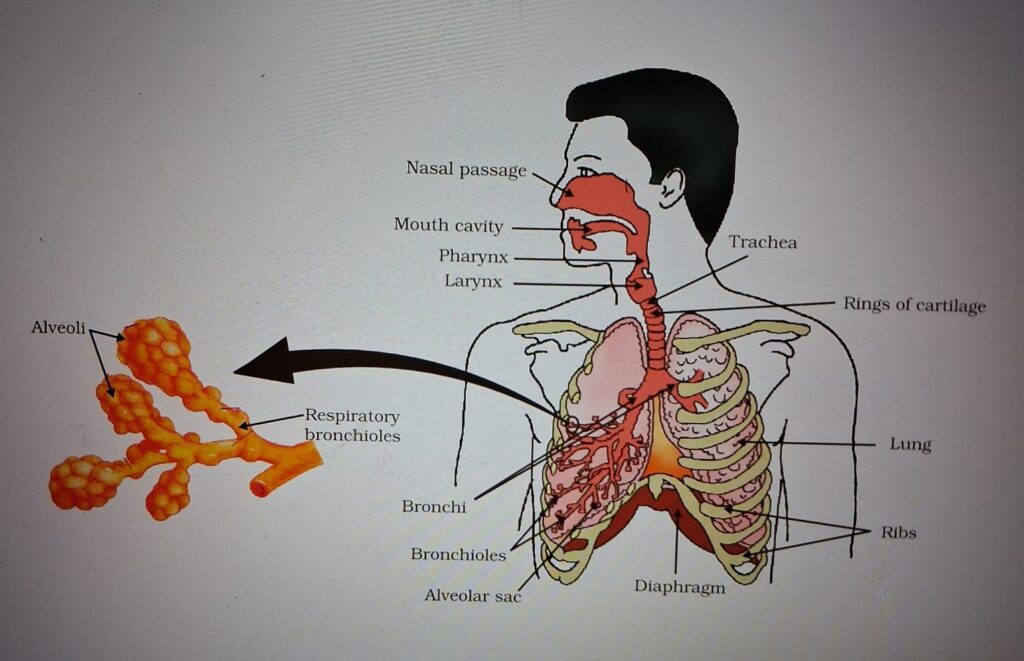
Q. Define a. Aorta b. Vena cava c. Septum d. Vein e. Artery f. Capillary
Ans.
- Aorta: It is the largest artery that transport oxygenated blood from left ventricle to other body parts.
- Vena Cava: It is the largest vein that receive de-oxygenated from veins. It connects right atrium. Right atrium receives de-oxygenated blood from vena Cava.
- Septum: wall that separates the heart into two sides, preventing oxygenated and deoxygenated blood from mixing.
- Vein: It is a type of blood vessel which carry de-oxygenated blood from body to heart, except pulmonary vein which carry oxygenated blood from lungs to heart ( left atrium). It consists of valv which prevent back flow of blood. Walls are thin . Blood pressure in vein is less.
- Artery: It is a type of blood vessel which carry oxygenated blood from heart to other body parts, except pulmonary artery which de-oxygenated blood from heart to lungs. Blood pressure in artery is high. Walls of artery is thick and elastic.
- Capillary: It is the thinnest blood vessel which is one cell thick. It connects artery and vein to cell. Artery divides into numerous capillaries and numerous capillaries join to form vein.
Q. Explain lymph.
Ans. Through the pores present in the walls of capillaries some amount of plasma, proteins and blood cells escape into intercellular spaces in the tissues to form the tissue fluid or lymph. It issimilar to the plasma of blood but colourless and contains less protein. Lymph drains into lymphatic capillaries from the intercellular spaces,which join to form large lymph vessels that finally open into larger veins. Lymph carries digested and absorbed fat from intestine and drains excess fluid from extra cellular space back into the blood.
Q. Define double circulation. Why it is compulsory for warm blooded animals?
Ans. When blood passes through the heart twice during a single cycle , it is called double circulation. Double circulation insures separation of oxygenated and de-oxygenated blood. Warm blooded animals have high energy requirement so as to maintain their body temperature. To fulfill their energy requirement efficient supply of exygen is required which is only possible with four chamber heart and double circulation. Cold blooded animals have less energy requirement so they do not require double circulation and have less number their heart chamber. For example fish have two chambered heart.
Q. Explain transportation of water in plants.
Ans. At the roots, cells in contact with the soil actively take up ions. This creates a difference in the
concentration of these ions between the root and the soil. Water, therefore, moves into the root from the soil to eliminate this difference. This means that there is steady movement of water into root xylem, creating a column of water that is steadily pushed upwards. However, this pressure by itself is unlikely to be enough to move water over the heights that we commonly see in plants. Plants use another strategy that is transpirational pull to move water in the xylem upwards to the highest points of the plant body. Due to transpiration a vacuum like situation develop in plant which create a pull upward.
Q. Explain translocation or transport of food and minerals in plants.
Ans. The translocation of food and other substances takes place in the sieve tubes with the help of adjacent companion cells both in upward and downward directions. translocation in phloem is achieved by utilising energy. Material like sucrose is transferred into phloem tissue using energy from ATP. This increases the osmotic pressure of the tissue causing water to move into it. This pressure moves the material in the phloem to tissues which have less pressure. This allows the phloem to move material according to the plant’s needs. For example, in the spring, sugar stored in root or stem tissue would be transported to the buds which need energy to grow.
Q. List Excretory System parts in humans.
Ans. The excretory system of human beings includes a pair of kidneys, a pair of ureters, a urinary bladder and a urethra.
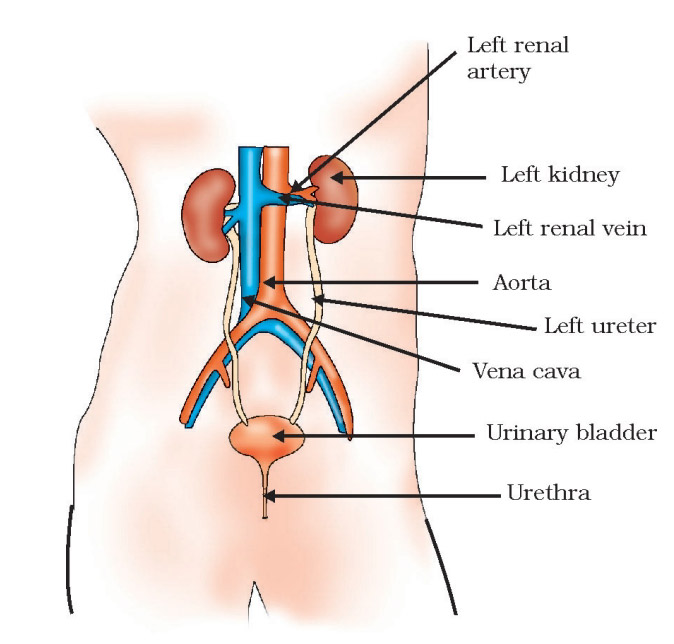
Q. Write function of kidney.
Ans. Nitrogenous waste such as urea or uric acid are removed from blood in the kidneys that means kidney is the filters blood and make blood free from harmful chemicals and substances.
Q. Write function of nephron and formation of urine in human.
Ans. Each kidney has large numbers of these filtration units called nephrons. The glomerulus is a bundle of tiny blood vessels in the nephron that filters blood and creates urine. Bowman’s capsule encloses a cluster of microscopic blood vessels called the glomerulus. Some substances in the initial filtrate, such as glucose, amino acids, salts and a major amount of water, are selectively re-absorbed.
The amount of water re-absorbed depends on how much excess water there isin the body, and on how much of dissolved waste there is to be excreted.